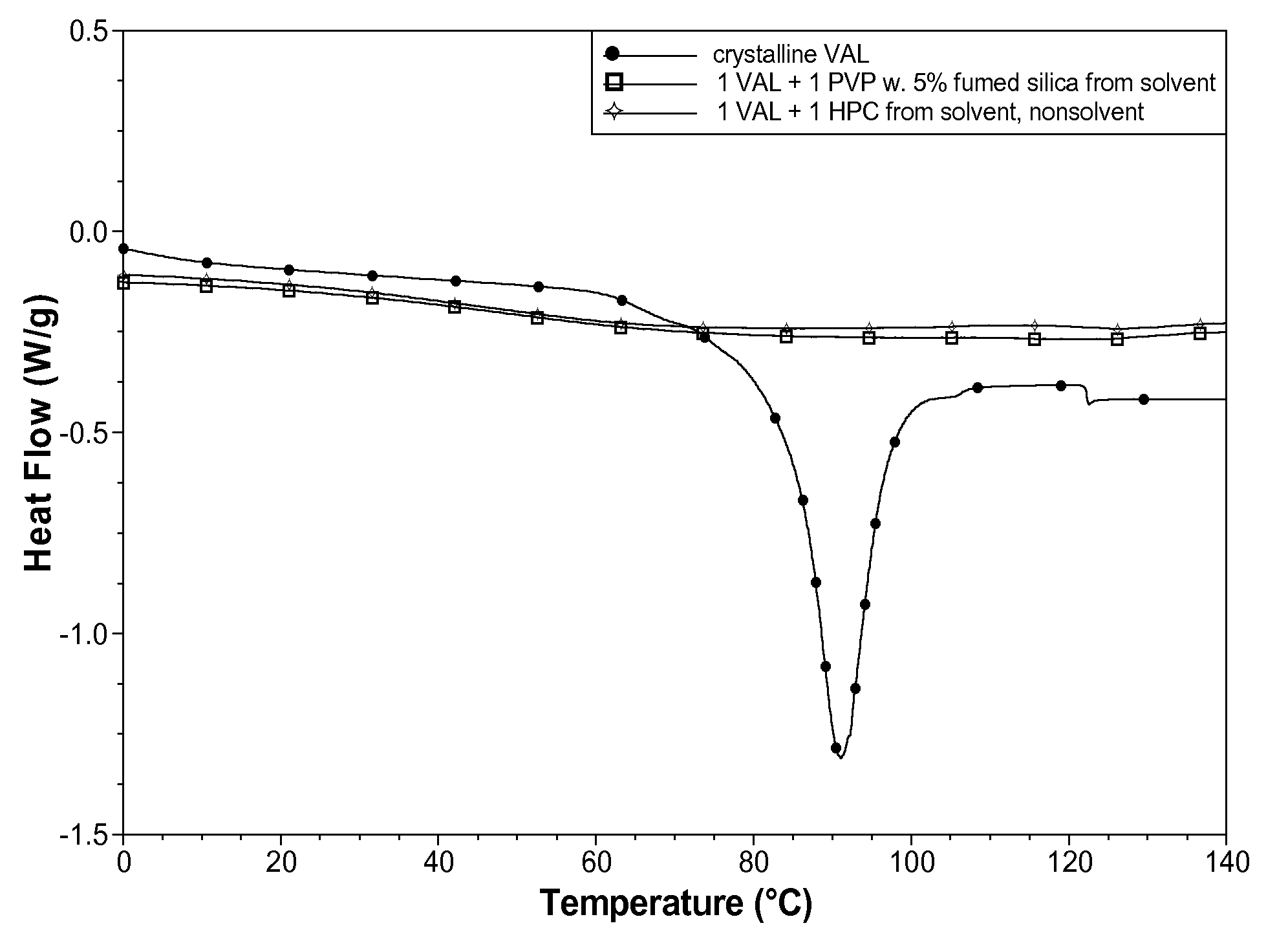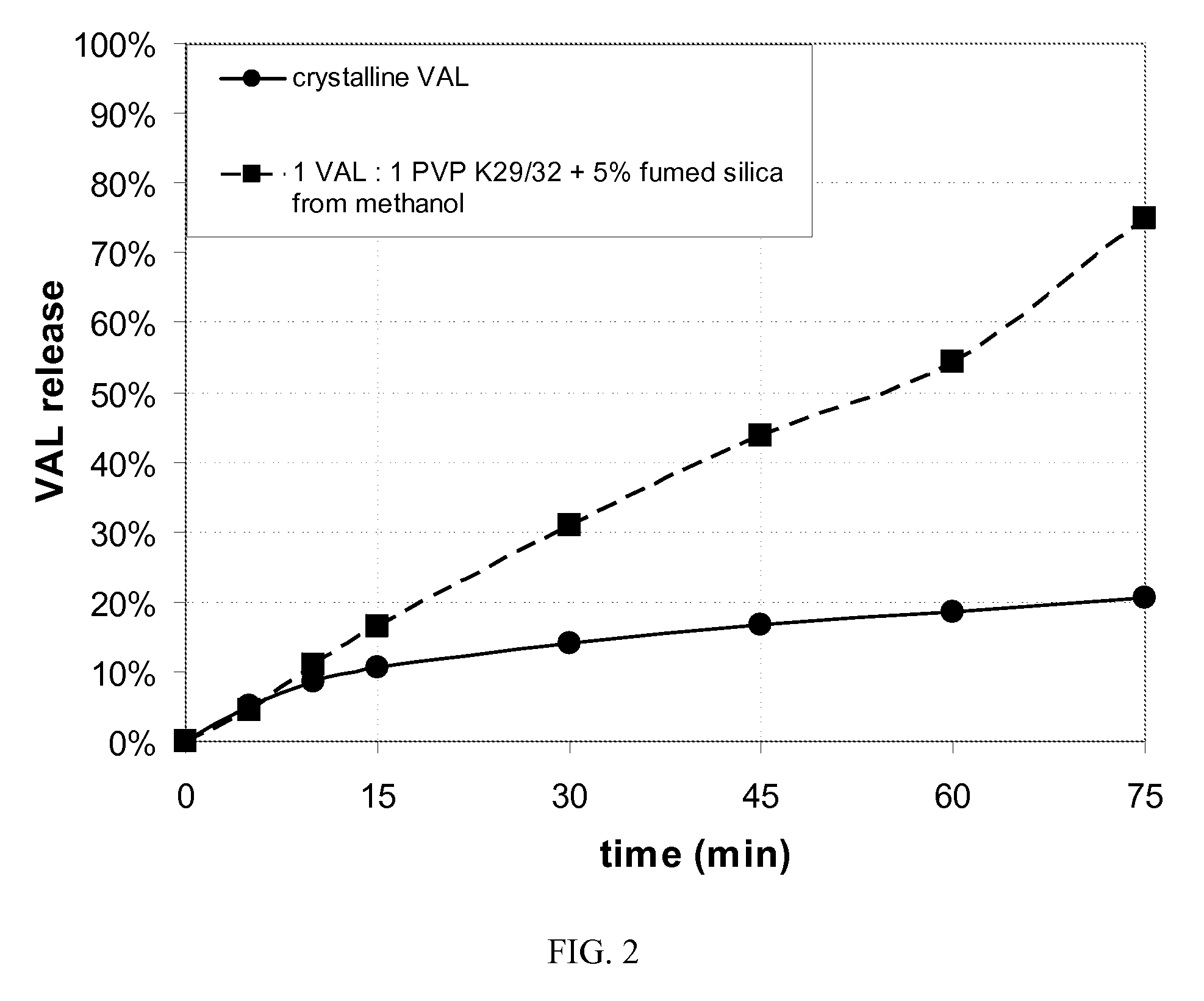Amorphous valsartan and the production thereof
a technology of amorphous valsartan and amorphous valsartan, which is applied in the field of compositions containing amorphous valsartan, can solve the problems of insufficient solvent composition to maintain the polymer in solution, and achieve the effects of reducing residual solvent content, increasing powder density, and increasing bulk powder density
- Summary
- Abstract
- Description
- Claims
- Application Information
AI Technical Summary
Benefits of technology
Problems solved by technology
Method used
Image
Examples
example 1
[0075]Two spray dried powders were produced on a Mini Spray Dryer (Buchi Labortechnik AG). The first powder was prepared by the solvent only method and contained 47.4% VAL, 47.7% PVP (Plasdone® K-29 / 32, ISP Corp.), and 4.9% fumed silica (Aerosil, Degussa Corp.) and was spray dried at 5% total solids from methanol which is a solvent for PVP. The second powder was prepared by the solvent / non-solvent method and contained 50% VAL and 50% HPC (Klucel® EF, Hercules, Inc.) and was spray dried at 5% total solids from a methanol / ethyl acetate solution. Methanol is a solvent for HPC while ethyl acetate is a non-solvent.
[0076]The crystallinity of the two powders was evaluated using DSC (Q1000, TA Instruments). Both powders contained VAL only in the amorphous form, as indicated by a lack of a DSC endothermic (i.e., melting) thermal event (FIG. 1)
[0077]Dissolution properties of the two amorphous spray dried powders and the crystalline drug were measured using a Varian 7010 dissolution bath (appa...
example 2
[0078]The relative bioavailability of the PVP based composition of Example 1 was compared to the crystalline form in male Sprague Dawley rat in a parallel study design. An oral, solid dose of 100 mg / kg was administered to the rats in the fasted state. The amorphous VAL composition achieved 40% higher bioavailability, as indicated by area under the twenty-hour hour drug plasma concentration vs. time (AUC0-24h) profile of 40 μg h / mL for the crystalline form vs. 56 μg h / mL for the spray dried amorphous form. Results are significant to the 95% confidence level.
example 3
[0079]Three spray dried powders were produced using a Mini Spray Dryer (Buchi Labortechnik AG). The powders were 1 VAL: 1 polyvinylpyrrolidone (Plasdone® K-12) (ISP) from a blend of dichloromethane / acetone, 1 VAL: 1 polyvinylpyrrolidone-co-vinyl acetate (Plasdone® S-630) (ISP) from a blend of dichloromethane / acetone, and 1 VAL: 1 hydroxypropylmethylcellulose (Pharmacoat® 603) (Shin-Etsu Chemical Co. Ltd.) from a blend of dichloromethane / methanol. While dichloromethane is a solvent for polyvinylpyrrolidone, acetone is a non-solvent, in that it does not swell the polymer molecule (α<1).
[0080]All powders contained amorphous VAL, as evidenced by the lack of a melting endotherm as measured by DSC (Q1000, TA Instruments).
PUM
| Property | Measurement | Unit |
|---|---|---|
| size | aaaaa | aaaaa |
| diameter | aaaaa | aaaaa |
| size | aaaaa | aaaaa |
Abstract
Description
Claims
Application Information
 Login to View More
Login to View More - R&D
- Intellectual Property
- Life Sciences
- Materials
- Tech Scout
- Unparalleled Data Quality
- Higher Quality Content
- 60% Fewer Hallucinations
Browse by: Latest US Patents, China's latest patents, Technical Efficacy Thesaurus, Application Domain, Technology Topic, Popular Technical Reports.
© 2025 PatSnap. All rights reserved.Legal|Privacy policy|Modern Slavery Act Transparency Statement|Sitemap|About US| Contact US: help@patsnap.com



